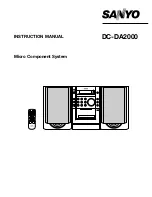
30
EURODESK MX3282A
A vocal signal can be enhanced by applying a significant boost in the 12 kHz region or higher, above the nasty
sibilance region. This is especially effective if youve got a de-esser patched post-EQ.
+
Use the low-cut filter to tighten up channels in a mix: maybe remove it only for the bass, kick
drum, toms, tablas, didgeridoo and other deliberate subsonics (when recording classical music
ignore this advice).
With the LF set to boost and the low-cut switch activated, you have got a peak response rather than shelving
at the bottom. Good for tight but deep bass.
Remember EQ contouring can be done with cut as well as with boost. Cutting away the top and bottom, then
pushing up the gain is equivalent to mid range boost! EQ is not a one way street!
Always reset a channels input gain (or external devices output level) after altering the amount of desk EQ cut
or boost applied.
11.1.2Gain Optimization
PFL (Pre-Fader-Listen) is the way to set a desk level. Master aux send levels are fixed at unity gain. As the mix
progresses, more and more channels are likely to be sending to effects via the aux buses, and its best to PFL
all sends just before setting up for the final mix.
Outboard reverbs etc. should all be made to work hard. Theres no point in having an 85 dB dynamic range if the
input meter of your reverb is barely flickering. On the other hand, digital distortion is not one of the nicer noises
around. Youll have to rely on your ears to detect digital distortion, since different outboard processors calibrate
their meters differently.
If you hear distortion, turn down the input on the FX unit, and turn up the desks aux return input.
99 times out of 100 distortion in the aux send > FX > aux return loop will come from the FX unit (FX gain too
high), and the same goes for a high noise level (FX gain too low).
Analog multitrack tape should be driven quite hard, since its dynamic range (without noise reduction) is likely
to be 20 to 30 dB worse than other elements in the recording chain. Try to record bright. You can always mix
back duller. Brightening up an off-tape signal will bring up the level of tape noise. With digital tape or hard disk
you have plenty of dynamic range, and treble pre-emphasis is not often necessary. Just dont let the signal
distort!
When mixing or recording, keep the channel fader levels around or below 0 dB. If you do find the faders
creeping up or down, apply a suitable offset over all channel faders, and try to control your bad habit in future!
12. EXPANDING
When the EURODESK is your main mixer, you may find that you run out of inputs as your system expands.
It is possible to expand your mixing system by combining two or more mixers.
Adding extra line inputs to your EURODESK
A small line mixer (such as the BEHRINGER ULTRALINK PRO MX882 8+2 Channel Mixer/Splitter/Signal
Router) can inexpensively add extra line inputs to your console. With the ULTRALINK PRO, any stereo,
line-level input on your EURODESK can become a stereo line input plus a further 6 pan-able mono line inputs.
Great for adding tape monitor returns etc.
The EURODESK outputs are essentially submixes of several channels of sound, and are therefore likely to be
considerably higher than the typical source signals (coming from mics, MIDI instruments or tape) seen by the
master console. Therefore, we recommend a reduction of gain in those channels of the master console that are
fed by the EURODESKs outputs.
Linking the EURODESK to a master console
Feed any or all of the main mix, subgroup outputs and aux outputs from your EURODESK into separate input
channels of the master console. The aux outputs should be routed only to individual aux send buses on the
master console. Now the aux sends from the EURODESK can access effects currently used by the master
console.
12. EXPANDING
All manuals and user guides at all-guides.com




































